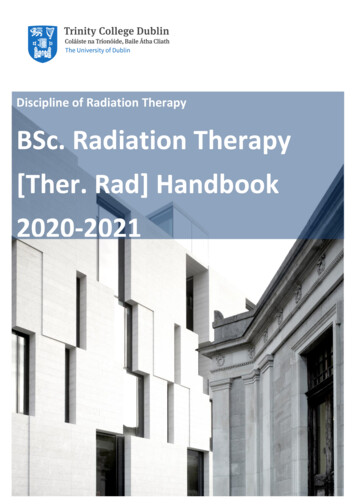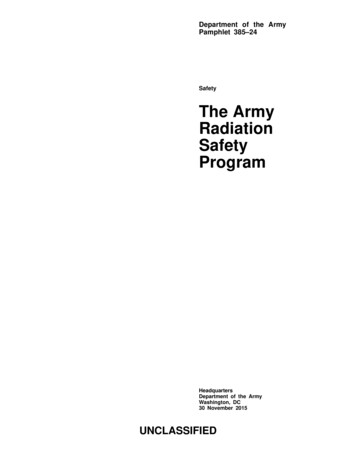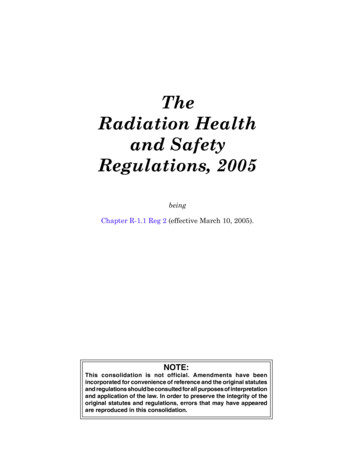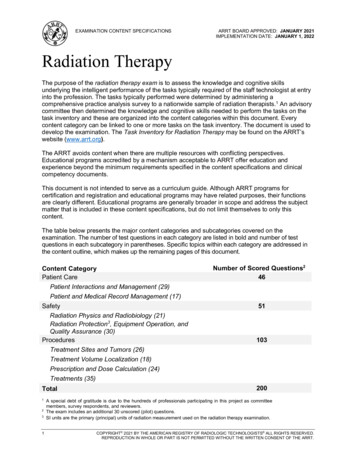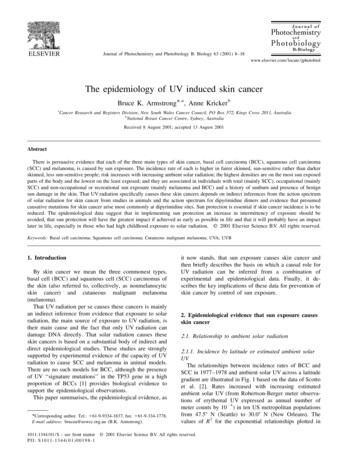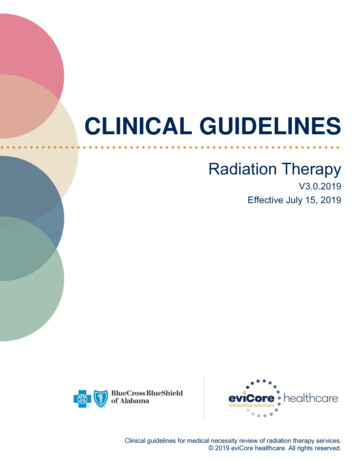
Transcription
CLINICAL GUIDELINESRadiation TherapyV3.0.2019Effective July 15, 2019Clinical guidelines for medical necessity review of radiation therapy services. 2019 eviCore healthcare. All rights reserved.
Radiation Therapy CriteriaV3.0.2019Please note the following:CPT Copyright 2017 American Medical Association. All rights reserved.CPT is a registered trademark of the American Medical Association. 2019 eviCore healthcare. All Rights Reserved.Page 2 of 251400 Buckwalter Place Boulevard, Bluffton, SC 29910 (800) 918-8924www.eviCore.com
Radiation Therapy CriteriaV3.0.2019Please note the following:All information provided by the NCCN is “Referenced with permission from the NCCNClinical Practice Guidelines in Oncology (NCCN Guidelines ) 2018/2019 NationalComprehensive Cancer Network. The NCCN Guidelines and illustrations herein maynot be reproduced in any form for any purpose without the express written permission ofthe NCCN. To view the most recent and complete version of the NCCN Guidelines, goonline to NCCN.org.” 2019 eviCore healthcare. All Rights Reserved.Page 3 of 251400 Buckwalter Place Boulevard, Bluffton, SC 29910 (800) 918-8924www.eviCore.com
Radiation Therapy CriteriaV3.0.2019Dear Provider,This document provides detailed descriptions of eviCore’s basic criteria (alsoknown as clinical guidelines) for radiation therapy arranged by diagnosis. Theyhave been carefully researched and are continually updated in order to beconsistent with the most current evidence-based guidelines andrecommendations for the provision of radiation therapy from national medicalsocieties and evidence-based medicine research centers. In addition, the criteriaare supplemented by information published in peer-reviewed literature.Our health plan clients review the development and application of these criteria.Every eviCore health plan client develops a unique list of CPT codes ordiagnoses that are part of their radiation therapy utilization managementprograms. Health Plan medical policy supersedes the eviCore criteria when thereis conflict with the eviCore criteria and the health plan medical policy. If you areunsure of whether or not a specific health plan has made modifications to thesebasic criteria in their medical policy for Radiation Therapy please contact the planor access the plan’s website for additional information.While eviCore encourages participation in clinical trials when consistent witheach health plan’s policies, we want to clarify our position on the use of suchstandard arms outside of the research setting. The use of a control arm orstandard arm in a Phase III clinical trial does not necessarily mean that otherstandard treatment techniques are not equally effective. Examples of multiple“standard” arms can easily be found in the treatment of prostate cancer whereIntensity-Modulated Radiation Therapy (IMRT), 3-Dimensional (3-D), low doseimplant or High Dose Rate (HDR) can be equally effective or breast cancerwhere standard whole breast fractionation or hypo-fractionation can be used.Indeed, national criteria such as National Comprehensive Cancer Network 2019 eviCore healthcare. All Rights Reserved.Page 4 of 251400 Buckwalter Place Boulevard, Bluffton, SC 29910 (800) 918-8924www.eviCore.com
Radiation Therapy CriteriaV3.0.2019(NCCN) and American College of Radiology (ACR) Appropriateness Criteriaoften suggest more than one radiation technique.It is eviCore’s process to apply evidence-based criteria to the particular clinicalcharacteristics in evaluating a case, and to certify the most appropriateregimen/modality. This regimen/modality may match one that is used as a“standard arm” in a federally funded clinical trial, or it may be one that isconsidered an “alternate standard”. The alternate standard will be one supportedby nationally published guidelines such as the NCCN, ACR AppropriatenessGuidelines, or American Society for Radiation Oncology (ASTRO) EvidenceBased Guidelines, or supported by other acceptable peer-reviewed publications.As such, eviCore will not automatically certify a case based solely on the fact thatit matches the standard (control) arm of a clinical trial. This concept applies alsoto regimens/modalities listed by the NCCN or ACR as “acceptable” treatments forspecific disease sites. Rather, we commit to working with the providing RadiationOncologist to certify the most appropriate regimen/modality for a particular case.eviCore healthcare works hard to make your clinical review experience apleasant one. For that reason, we have peer reviewers available to assist youshould you have specific questions about a procedure.For your convenience, eviCore’s Customer Service support is available from7 a.m. to 7 p.m. Our toll free number is (800) 918-8924.Gregg P. Allen, M.D. FAAFPEVP and Chief Medical Officer 2019 eviCore healthcare. All Rights Reserved.Page 5 of 251400 Buckwalter Place Boulevard, Bluffton, SC 29910 (800) 918-8924www.eviCore.com
Radiation Therapy CriteriaV3.0.2019Table of ContentsHyperthermiaImage-Guided Radiation Therapy (IGRT)Neutron Beam TherapyProton Beam TherapyRadiation Therapy for Anal Canal CancerRadiation Therapy for Bladder CancerRadiation Therapy for Bone MetastasesRadiation Therapy for Brain MetastasesRadiation Therapy for Breast CancerRadiation Therapy for Cervical CancerRadiation Therapy for Endometrial CancerRadiation Therapy for Esophageal CancerRadiation Therapy for Gastric CancerRadiation Therapy for Head and Neck CancerRadiation Therapy for Hepatobiliary CancerRadiation Therapy for HodgkinRadiation Therapy for Kidney and Adrenal CancerRadiation Therapy for Multiple Myeloma and SolitaryPlasmacytomasRadiation Therapy for Non-Hodgkin’s LymphomaRadiation Therapy for Non-malignant DiseaseRadiation Therapy for Non-Small Cell Lung CancerRadiation Therapy for OligometastasesRadiation Therapy for Other CancersRadiation Therapy for Pancreatic CancerRadiation Therapy for Primary Craniospinal Tumors andNeurologic ConditionsRadiation Therapy for Prostate CancerRadiation Therapy for Rectal CancerRadiation Therapy for Skin CancerRadiation Therapy for Small Cell Lung CancerRadiation Therapy for Soft Tissue SarcomasRadiation Therapy for Testicular CancerRadiation Therapy for Thymoma and Thymic CancerRadiation Therapy for Urethral Cancer and Upper GenitourinaryTract TumorsRadiation Treatment with Azedra (iobenguane I-131)Radiation Treatment with Lutathera (Lutetium; Lu 177 dotatate)Radioimmunotherapy with Zevalin Selective Internal Radiation 235246 2019 eviCore healthcare. All Rights Reserved.Page 6 of 251400 Buckwalter Place Boulevard, Bluffton, SC 29910 (800) 918-8924www.eviCore.com
Radiation Therapy CriteriaV3.0.2019HyperthermiaPOLICYI. The use of hyperthermia and concurrent radiation therapy treatment ismedically necessary for any of the following:A. Superficially recurrent melanomaB. Chest wall recurrence of breast cancerC. Recurrent cervical lymph nodes from head and neck cancerTreatment of the above conditions will be approved in the absence of both of thefollowing:D. Metastatic disease for which chemotherapy or hormonal therapy is being givenconcurrently or plannedE. Evidence of tumor recurrence exceeding 4 cm in depthWhen hyperthermia is indicated, no more than 10 hyperthermia treatmentsdelivered twice weekly at 72-hour intervals should be utilized.II. The use of intraluminal, endocavitary, interstitial, regional deep tissuehyperthermia exceeding 4 cm in depth, and whole body hyperthermia isconsidered experimental, investigational, or unproven (EIU)Key Clinical PointsAfter initial enthusiasm for the use of hyperthermia in the late 1970s, interest waned withthe publication of studies showing little or no benefit in the mid-1980s. Later review of thenegative findings disclosed that the critical temperature necessary for hyperthermic celldeath, 42 to 43 degrees centigrade (C), was either poorly measured or poorly maintainedin these studies. Point measurements rather than volume mapping of thermal gradientswere relied upon in planning these hyperthermia studies.Renewed interest in the use of hyperthermia began to emerge in both Europe and theUnited States (US) in the 1990s. Research from Duke University, NorthwesternUniversity, University of Southern California, Stanford University, Washington University,as well as centers in Holland, Germany, Norway, Austria, Italy, and Switzerland havecontributed substantially to the emergence of hyperthermia as a useful treatment modalitywhen combined with radiation therapy.Currently, in the US, the Food and Drug Administration (FDA) has approved hyperthermiafor use in the treatment of cancer when combined with radiation therapy for the“ palliative management of certain solid surface and subsurface malignant tumors (i.e.melanoma, squamous or basal cell tumors, adenocarcinoma, or sarcoma) that areprogressive or recurrent despite conventional therapy.” The National Cancer CenterNetwork (NCCN) recommends “ that the use of hyperthermia be limited to treatment 2019 eviCore healthcare. All Rights Reserved.Page 7 of 251400 Buckwalter Place Boulevard, Bluffton, SC 29910 (800) 918-8924www.eviCore.com
Radiation Therapy CriteriaV3.0.2019centers with appropriate training, expertise and equipment.”. The NCCN Panel on BreastCancer concluded that it was a controversial Category 3 recommendation in the treatmentof local or regional recurrent breast cancer.Following FDA approval, Medicare approved coverage for local hyperthermia when usedtogether with radiation therapy. A National Coverage Determination (NCD 110.1) wasissued by Medicare (CMS) in December 1984 and remains unchanged. It states, “Localhyperthermia is covered under Medicare when used in conjunction with radiation therapyfor the treatment of primary or metastatic cutaneous or subcutaneous superficialmalignancies. It is not covered when used alone or in connection with chemotherapy.”Coding for this treatment is recognized and published in the current 2018 ACR/ASTROguide.Although research into hyperthermic treatments at depths greater than 4 cm is ongoingin the US, it is currently recognized only as investigational as are intraluminal,endocavitary, and interstitial applications.On May 15, 2009, the FDA granted humanitarian use device (HUD) status to the BSD2000 and on November 18, 2011, the FDA granted humanitarian device exemption (HDE)to the BSD-2000 for the treatment of cervical cancer patients ineligible for chemotherapy(treatment population less than 4,000). This is the only approval for deep heating, andonly actual costs incurred in the research may be billed. Other applications for deepheating are pending for both BSD and Medifocus devices.In the US, only the BSD-500 has FDA commercial clearance for superficial heating (lessthan a 4 cm depth). This is currently the only device approved for reimbursement. Itoperates at the microwave range of 915 MHz with different applicators and power settingranging from 20 to 250 watts. The standard recommended treatment regimen for use withradiation therapy is a “ total of 10 hyperthermia treatments delivered two times per weekat 72-hour intervals, with each heat treatment preceded or followed by a standardprescribed dose of ionizing radiation within 30 minutes of the heat treatment.” A sustainedintratumoral temperature of 42.5 degrees C for 60 minutes is recommended.The FDA granted pre-market approval for the Sonotherm 1000 Ultrasound TherapySystem on September 29, 1989. This approval was for hyperthermia to treat tumors at adepth of 8 cm. Although FDA approval was granted, the device remains in clinical studyand is designated EIU.1. Melanoma – 134 metastatic or recurrent lesions of malignant melanoma in 70patients were randomly assigned to receive radiation therapy (three fractionsof 8 or 9 Gy over 8 days) alone or followed by hyperthermia (43 degrees C for60 minutes). Beneficial local effect was 28% for radiation alone, and 46% forcombined treatment. Toxicity was not higher with hyperthermia (Overgaard,1995) 2019 eviCore healthcare. All Rights Reserved.Page 8 of 251400 Buckwalter Place Boulevard, Bluffton, SC 29910 (800) 918-8924www.eviCore.comHyperthermiaThere are three clinical sites in which randomized studies have documented the benefitof hyperthermia given in conjunction with radiotherapy.
Radiation Therapy CriteriaV3.0.20192. Breast – Five randomized trials were combined to report the benefit ofcombined treatment for superficial localized breast cancer. The control rate forradiation therapy alone was 41%, while that for combined treatment was 59%.The greatest effect was observed in patients with recurrent lesions in previouslyirradiated lesions where further irradiation was limited to low doses (Vernon,1996)3. Head and neck metastatic lymph nodes – a randomized study of 44 nodes in41 patients confirmed the improved five-year actuarial nodal control of thecombined treatment arm. In addition, the study reports a statistically significantimprovement in survival at five years and no increased toxicity from combinedmodality therapy (Valdagni, 1994)HyperthermiaReferences:1. American College of Radiology (ACR)/American Society of Radiation Therapy (ASTRO) Coding Guide. AccessedSeptember 10, 2018.2. BSD-2000 Brochure. Accessed September 10, 2018.3. BSD-500 Brochure. Accessed September 10, 2018.4. HUD and HDE for BSD-2000. Accessed September 10, 2018.5. Hyperthermia for Treatment of Cancer. National Coverage Determination (NCD) 110.1. Accessed September 10,2018.6. National Comprehensive Cancer Network (NCCN) Guidelines. Version 1.2018 – March 20, 2018. Breast Cancer.Accessed September 10, 2018. Referenced with permission from the NCCN Clinical Practice Guidelines inOncology (NCCN Guidelines ) for Breast Cancer Version 1.2018 . 2018 National Comprehensive CancerNetwork, Inc. All rights reserved. The NCCN Guidelines and illustrations herein may not be reproduced in anyform for any purpose without the express written permission of the NCCN. To view the most recent and completeversion of the NCCN Guidelines, go online to NCCN.org.7. Overgaard J, Gonzalez D, Hulshof MC, et al. Randomised trial of hyperthermia as adjuvant to radiotherapy forrecurrent or metastatic malignant melanoma. European Society for Hyperthermic Oncology. Lancet. 1995 Mar 4;345(8949):540-543.Accessed September 10, 2018.8. PMA for BSD-500.Accessed September 10, 2018. and supplement9. Sonotherm 1000 Ultrasound Therapy System. Accessed September 10, 2018.10. Valdagni R, Amichetti M. Report of long-term follow up in a randomized trial comparing radiation therapy andradiation therapy plus hyperthermia to metastatic lymph nodes in stage IV head and neck patients. Int. J. Radiat.Oncol. Biol. Phys. 1994 Jan 1; 28(1):163–169. Accessed September 10, 2018.11. Vernon CC, Hand JW, Field SB et al. Radiotherapy with or without hyperthermia in the treatment of superficiallocalized breast cancer: results from five randomized controlled trials. International Collaborative HyperthermiaGroup. Int J Radiat Oncol Biol Phys. 1996 Jul 1; 35(4):731-744. Accessed September 10, 2018. 2019 eviCore healthcare. All Rights Reserved.Page 9 of 251400 Buckwalter Place Boulevard, Bluffton, SC 29910 (800) 918-8924www.eviCore.com
Radiation Therapy CriteriaV3.0.2019Image-Guided Radiation Therapy (IGRT)POLICYI. IGRT during IMRTIGRT is considered medically necessary when IMRT has been approved and is beingutilized.II. IGRT during 3DCRTIGRT in conjunction with 3DCRT is medically necessary in the followingcircumstances:A. When the planning target volume (PTV) is in close proximity to a previouslyirradiated areaB. Treatment of the hepatobiliary tractC. Treatment of head and neck cancerD. Treatment of Hodgkin’s and Non-Hodgkin’s LymphomaE. Treatment of lung cancerF. Treatment of prostate cancerG. Treatment of esophageal cancerH. Treatment of gastric cancerI. Treatment of pancreatic cancerJ. Treatment of pelvic cancers (i.e. rectal cancer) when the individual is in the proneposition on a belly boardK. During breast boost when using photonsL. During external beam-based accelerated partial breast irradiation (APBI)M. During treatment of breast cancer when a DIBH technique is being usedN. Treatment of breast cancer when the individual is in the prone positionO. During the boost to the bladderP. Preoperative or postoperative treatment of sarcomas 2019 eviCore healthcare. All Rights Reserved.Page 10 of 251400 Buckwalter Place Boulevard, Bluffton, SC 29910 (800) 918-8924www.eviCore.com
Radiation Therapy CriteriaV3.0.2019III. IGRT during SRS/SBRTFor Stereotactic Body Radiation Therapy (SBRT), the IGRT codes may not be billedseparately because by American Medical Association (AMA) definition they arebundled and included in the daily treatment codes. In addition, the IGRT codes maynot be billed separately with Stereotactic Radiosurgery (SRS) as stated in the ASTROcoding guide.IV. IGRT and brachytherapyIn brachytherapy cases, imaging is medically necessary to verify source position in allbut the simplest of cases. The images may also be used to perform dosimetrycalculations. Use of applicable simulation and/or field verification codes is appropriate,such as CPT Code 77280.V. IGRT and superficial radiation therapy or electron beam therapyThe use of IGRT with either superficial radiation therapy or electron beam therapy isconsidered not medically necessary.IGRT is a method by which image guidance is applied to place the isocenter for theupcoming treatment appropriately. This technology typically is applied for an individualundergoing Intensity-Modulated Radiation Therapy (IMRT). However, in some cases inwhich the isocenter is the main concern, IGRT occasionally can be used with threedimensional (3D) conformal radiation therapy (3DCRT). The American Society forRadiation Oncology (ASTRO) together with the American College of Radiology (ACR)have published practice parameters (Loo et al, 2014) and technical standards (Cheng etal, 2014) regarding IGRT. In addition, in their 2018 Radiation Oncology Coding Resource,ASTRO has addressed IGRT in detail.Historical methodology of using port films to confirm patient set-up and block placementhas not been replaced by IGRT. For example, the Coding Resource states “ guidanceand tracking are not indicated " when " replacing ’port check’ imaging when targetlocalization is not medically necessary." Outside of treatment procedures requiring onlyisocenter placement, port films and/or verification simulations are still the appropriatemodalities. If the isocenter placement is the primary concern, i.e. for IMRT, then IGRT istypically the method utilized. This does, however, imply the target can be localized withthe specific IGRT modality requested, i.e., stereoscopic imaging for target localization,computed tomography (CT) guidance for field placement or ultrasound (US) guidance forfield placement (Weiss et al., 2011). In the event no target is localized, blocking andpatient set-up is accomplished through typical alignment of bony structures using portalimaging; appropriate coding for port films would apply.Effective 1/1/2015, IGRT techniques are covered under two different coding systems.CPT code 77387 is for billing in the Hospital Outpatient Prospective Payment System(HOPPS) and for those non-Medicare health plans that accept this definition. It may benecessary to check with the individual health plan directly before billing this code for this 2019 eviCore healthcare. All Rights Reserved.Page 11 of 251400 Buckwalter Place Boulevard, Bluffton, SC 29910 (800) 918-8924www.eviCore.comImage-Guided Radiation Therapy (IGRT)Key Clinical Points
Radiation Therapy CriteriaV3.0.2019purpose. Also, the new IMRT treatment delivery CPT codes (77385 and 77386) includeIGRT guidance and tracking, when performed. The technical component of IGRT(77387-TC) is packaged into the IMRT service with which it is performed and is notreported separately. In the Medicare Physician Fee Schedule (MPFS) setting, as well asthe Healthcare Common Procedure Coding System (HCPCS) setting, the G-Code systemhas replaced CPT codes. G6001 replaces CPT code 76950, G6002 replaces CPT code 77421, and G6017 replaces CPT code 0197T. In contrast to the HOPPS reporting,IGRT is not bundled into IMRT for MPFS and HCPCS and is reported separately.Respiratory motion management may be clinically appropriate for treating some cancers,including lung cancer and some cases of breast cancer (deep inspiration breath hold[DIBH]). Respiratory tracking by continuous localization systems or four-dimensional CT(4D-CT) are now included in CPT code 77387. This code is for billing in the HOPPS andfor those non-Medicare health plans that accept this definition. It may be necessary tocheck with the individual health plan directly before billing this code for this purpose. Inthe MPFS setting as well as the HCPCS setting, the G-Code G6017 has replaced CPT code 0197T. In the hospital-outpatient setting, G6017 is considered image guidance andis packaged into the primary service payment. For all other purposes, this code isconsidered carrier-priced and may be accepted or refused by different health plans andMedicare contractors.In IGRT-approved cases, only one method or technique of IGRT is allowed daily.References1. ASTRO coding FAQS and tips. Accessed September 11, 2018.2. ASTRO Radiation Oncology Coding Resource. Available on-line for purchase. Accessed September 11, 2018.3. Chadha M, Young A, Geraghty C, et al. Image guidance using 3D-ultrasound (3D-US) for daily positioning oflumpectomy cavity for boost irradiation. Radiat Oncol. 2011 May 9; 6:45. Accessed September 11, 2018.4. Chen Y-J, Suh S, Nelson RA, et al. Setup variations in radiotherapy of anal cancer: advantages of target volumereduction using image-guided radiation treatment (IGRT). Int J Radiat Oncol Biol Phys. 2012 Sep 1; 84(1):289295. Accessed September 11, 2018.5. Cheng C-W, Fontenot JD, Watchman CJ, et al. ACR-AAPM technical standard for medical physics performancemonitoring of image-guided radiation therapy (IGRT). Revised 2014 (Resolution 36). Accessed September 11,2018.6. Eldredge HB, Studenski M, Keith S, et al. IGRT after prostatectomy: evaluation of corrective shifts and toxicityusing online conebeam CT vs. weekly port films for target localization. Int J Radiat Oncol Biol Phys. 2010 Nov 1;78(3 Suppl):S380. Accessed September 11, 2018.7. Graff P, Hu W, Yom SS, et al. Does IGRT ensure target dose coverage of head and neck IMRT patients? RadiotherOncol. 2012 Jul; 104(1):83-90. Accessed September 11, 2018.8. Hyer DE, Serago CF, Kim S, et al. An organ and effective dose study of XVI and OBI cone-beam CT systems. JAppl Clin Med Phys. 2010 Apr 17; 11(2):3183. Accessed September 11, 2018.9. Jaffray D, Langen KM, Mageras G, et al. Safety considerations for IGRT: executive summary. Practical RadiationOncology. 2013 Jul-Sep; 3(3):167-170. Accessed September 11, 2018.10. Kan MW, Leung LHT, Wong W, et al. Radiation dose from cone beam computed tomography for image-guidedradiation therapy. Int J Radiat Oncol Biol Phys. 2008 Jan 1; 70(1):272-279. Accessed September 11, 2018.11. Leonard CE, Tallhamer M, Johnson T, et al. Clinical experience with image-guided radiotherapy in an acceleratedpartial breast intensity-modulated radiotherapy protocol. Int J Radiat Oncol Biol Phys. 2010 Feb 1; 76(2):528-534.Accessed September 11, 2018.12. Lisbona A, Averbeck D, Supiot S, et al. IMRT combined to IGRT: increase of the irradiated volume consequences?Cancer Radiother. 2010 Oct; 14(6-7):563-570. Accessed September 11, 2018. 2019 eviCore healthcare. All Rights Reserved.Page 12 of 251400 Buckwalter Place Boulevard, Bluffton, SC 29910 (800) 918-8924www.eviCore.comImage-Guided Radiation Therapy (IGRT)CPT codes 77370 and 77470 should not be billed based on the use of IGRT.
Radiation Therapy CriteriaV3.0.2019Image-Guided Radiation Therapy (IGRT)13. Loo Jr. BW, Bajaj GK, Galvin JM, et al. ACR-ASTRO practice parameter for image-guided radiation therapy (IGRT).Revised 2014 (CSC/BOC), Effective June 25, 2014. Accessed September 11, 2018.14. Mohammed N, Kestin L, Grills I, et al. Comparison of IGRT registration strategies for optimal coverage of primarylung tumors and involved nodes based on multiple four-dimensional CT scans obtained throughout theradiotherapy course. Int J Radiat Oncol Biol Phys. 2012 Mar 15; 82(4):1541-1548. Accessed September 11, 2018.15. Ottosson W, Baker M, Hedman M, et al. Evaluation of setup accuracy for NSCLC patients; studying the impact ofdifferent types of cone-beam CT matches based on whole thorax, columna vertebralis, and GTV. Acta Oncol. 2010Oct; 49(7):1184-1191. Accessed September 11, 2018.16. Park CK, Pritz J, Zhang GG, et al. Validating fiducial markers for image-guided radiation therapy for acceleratedpartial breast irradiation in early-stage breast cancer. Int J Radiat Oncol Biol Phys. 2012 Mar 1; 82(3):e425-e431.Accessed September 11, 2018.17. Sangalli G, Passoni P, Cattaneo GM, et al. Planning design of locally advanced pancreatic carcinoma using 4DCTand IMRT/IGRT technologies. Acta Oncol. 2011 Jan; 50(1):72-80. Accessed September 11, 2018.18. Shah A, Aird E, Shekhdar J. Contribution to normal tissue dose from concomitant radiation for two common kVCBCT systems and one MVCT system used in radiotherapy. Radiother Oncol. 2012 Oct; 105(1):139-144.Accessed September 11, 2018.19. Wang D, Zhang Q, Eisenberg BL, et al. Significant reduction of late toxicities in patients with extremity sarcomatreated with image-guided radiation therapy to a reduced target volume: results of Radiation Therapy OncologyGroup RTOG-0630 trial. J Clin Oncol. 2015 Feb 9. Published online before print. Accessed September 11, 2018.20. Weiss, K. IGRT, are you applying it correctly? Revenue Cycle. Radiation Oncology News. January 2011. AccessedSeptember 11, 2018.21. Zelefsky MJ, Kollmeier M, Cox B, et al. Improved clinical outcomes with high-dose image guided radiotherapycompared with non-IGRT for the treatment of clinically localized prostate cancer. Int J Radiat Oncol Biol Phys.2012 Sep 1; 84(1):125-129. Accessed September 11, 2018. 2019 eviCore healthcare. All Rights Reserved.Page 13 of 251400 Buckwalter Place Boulevard, Bluffton, SC 29910 (800) 918-8924www.eviCore.com
Radiation Therapy CriteriaV3.0.2019Neutron Beam TherapyPOLICYI. Neutron beam radiotherapy is considered medically necessary for salivarygland cancers that are inoperable, recurrent, or are resected with gross residualdisease or positive margins.II. All other indications are not covered because neutron beam radiotherapy isconsidered experimental, investigational, or unproven (EIU).Key Clinical PointsNeutron beam radiotherapy differs from other forms of radiation particle treatment suchas protons or electrons as neutrons have no electrical charge. The treatment effects arethe results of the neutron mass producing dense radiation energy distributions. This effectis high energy linear transfer (LET) and may offset the negative effects of low oxygentension in tumors, leading to increased rate of control in hypoxic tumors.There is limited research, resulting in a lack of substantial information on its clinicaleffectiveness, although it has been tried in soft tissue sarcoma, prostate cancer,pancreas, colon, and lung cancers amongst others. The lack of data and comparativetrials limits its designation to EIU, with the exception of salivary gland cancers. The useof this technique is highly experimental at this time. Currently, the University ofWashington Medical Cyclotron Facility in Seattle is the only clinical neutron facility in theUnited States.The effectiveness of neutrons as treatment of choice in the treatment of salivary glandtumors was most recently confirmed by Stannard et al. (2013) with the treatment of 335patients at IThemba Labs. The patients had either unresectable tumors or had grossmacroscopic residual disease. Local regional control was 60.6% at 5 years and 39.1%at 10 years. Disease specific survival was 66.8% at 5 years and 53.7% at 10 years. Arecent publication by Davis, et al. (2016) reported a 6 year overall survival of 58% in 140patients, with the most common subtype being adenoid cystic carcinoma and thesubmandibular gland being the most common site. The current standard neutron dosewas reported as 1.15 neutron Gray (nGy) 4 times per week for 4 weeks (total 18.4 nGy)equivalent to 60 to 70 Gy over 6 to 7 weeks with conventional photon radiation.Neutrons do have limitations, especially at the skull base, which can result in an increasedcomplication rate. Recent studies at the University of Washington (Douglas et. al, 2008;Rockhill and Laramore, 2016) have focused on reducing the neutron contribution at thesuperior portion of the tumor in skull-based tumors using SRS, Gamma Knife, as a boost.The 40 month actuarial control rate was 82% compared to a historical control rate of 39%with neutrons alone. 2019 eviCore healthcare. All Rights Reserved.Page 14 of 251400 Buckwalter Place Boulevard, Bluffton, SC 29910 (800) 918-8924www.eviCore.com
Radiation Therapy CriteriaV3.0.2019Neutron Beam TherapyReferences:1. Aihara T, Morita N, Kamitani N, et al. Boron neutron capture therapy for advanced salivary gland carcinoma inhead and neck. In J Clin Oncol. 2014 Jun; 19(3):437-444. Accessed September 12, 2018.2. American Society of Radiation Therapy (ASTRO) Coding Resource. Accessed September 12, 2018.3. Burmeister J, Spink R, Liang L, et al. Commissioning of intensity modulated neutron therapy (IMNRT). Med Phys2013 Feb; 40(2):021718. Accessed September 12, 2018.4. Davis C, Sikes J, Namaranian P, et al. Neutron beam radiation therapy: an overview of treatment and oralcomplications when treating salivary gland malignancies. J Oral Maxillofacial Surg. 2016 Apr; 74(4):830-835.Accessed September 12, 2018.5. Douglas JG, Good
Radiation Therapy Criteria (NCCN) and American College of Radiology (ACR) Appropriateness Criteria often suggest more than one radiation technique. . radiation therapy is a " total of 10 hyperthermia treatments delivered two times per week at 72-hour intervals, with each heat treatment preceded or followed by a standard .

